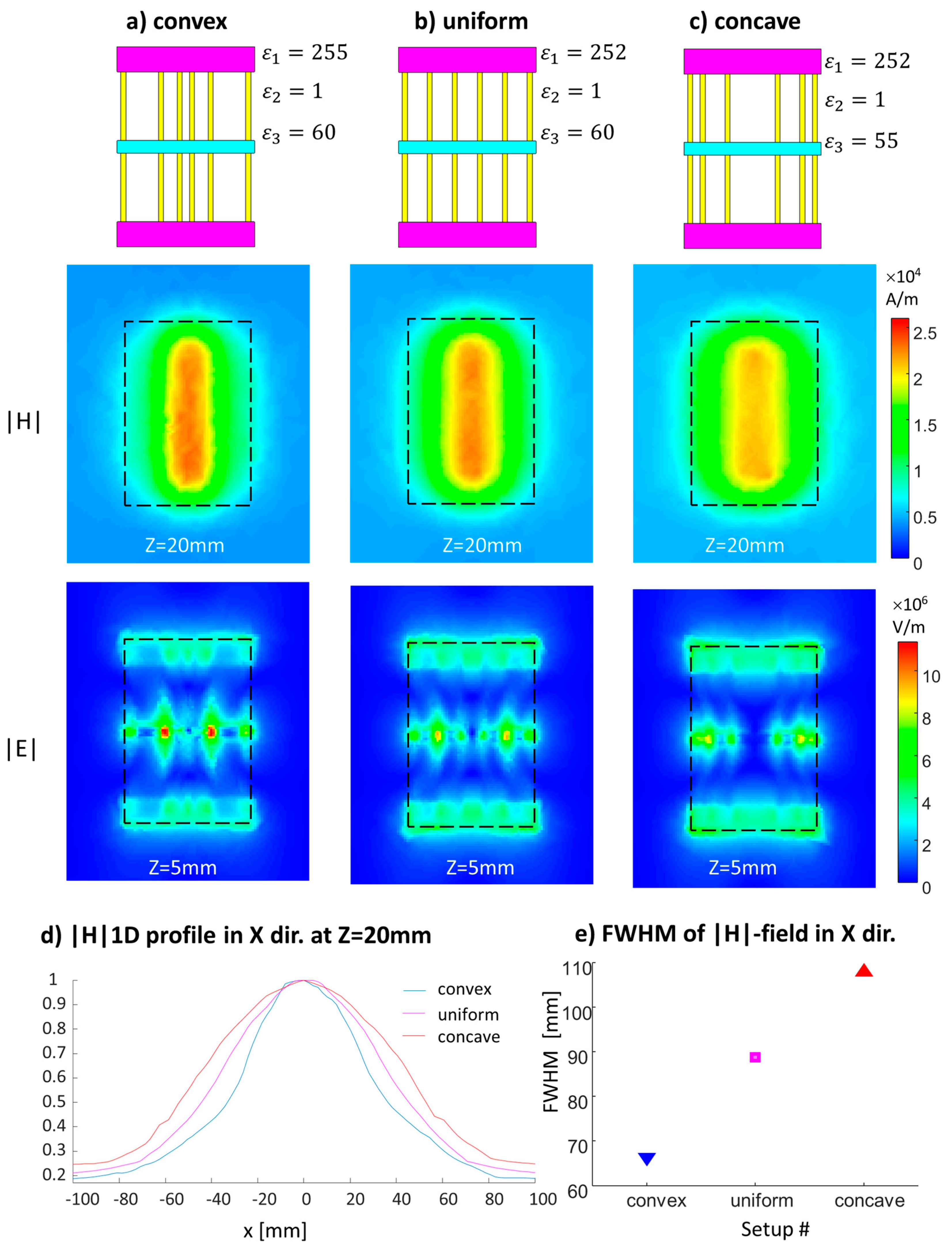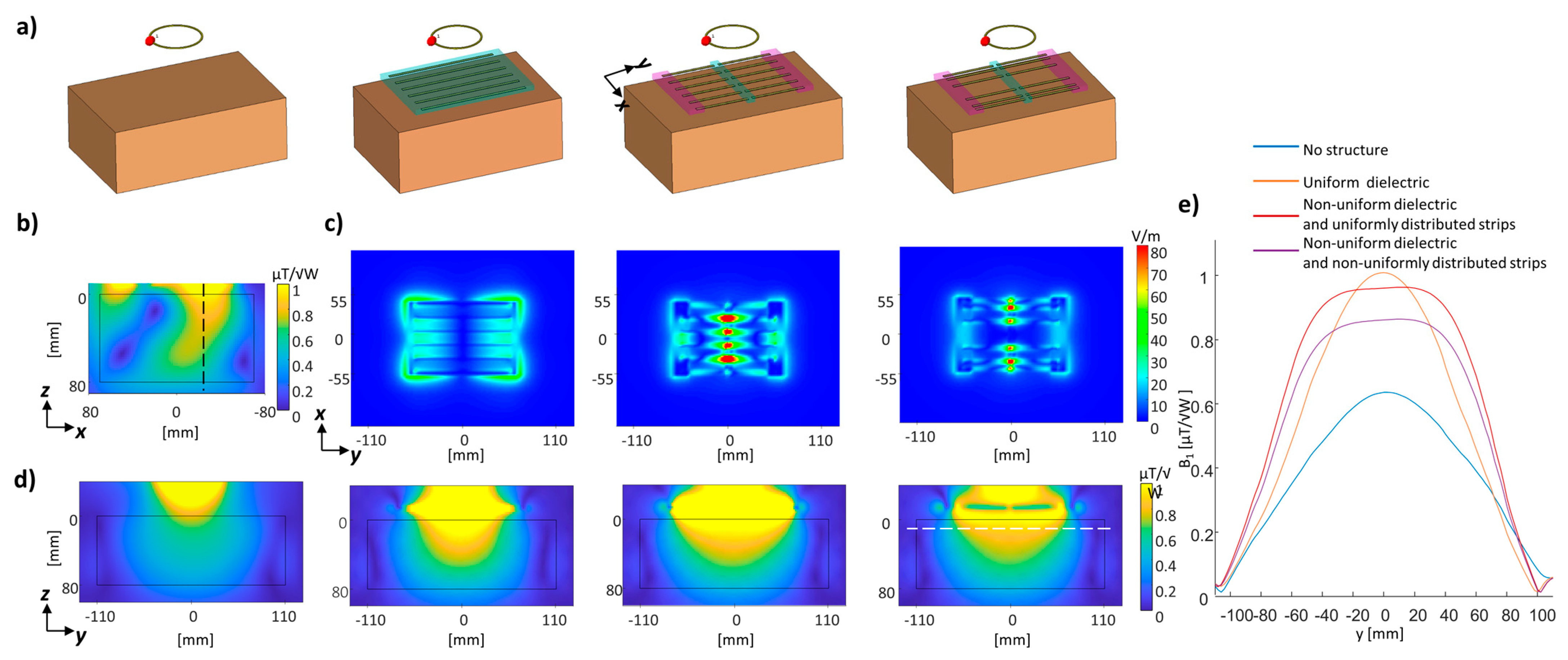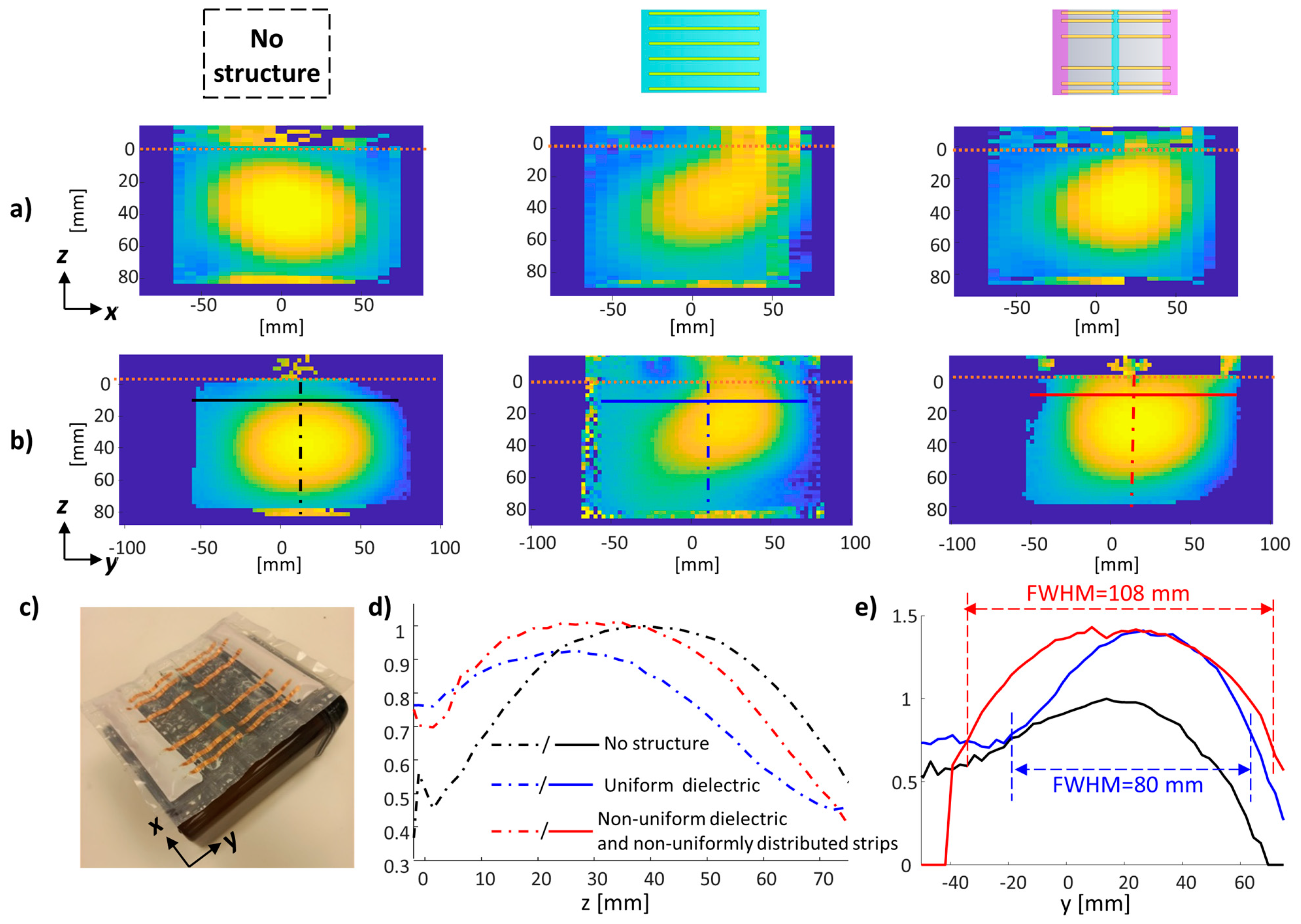A Metamaterial-like Structure Design Using Non-uniformly Distributed Dielectric and Conducting Strips to Boost the RF Field Distribution in 7 T MRI †
Abstract
1. Introduction
2. Materials and Methods
2.1. Characterization of the Non-uniform Dielectric Distribution
- A uniform dielectric with uniformly spaced copper strips: a dielectric layer with the relative permittivity (εr) = 72 and six copper strips equidistantly spaced 20 mm apart.
- A non-uniform dielectric with uniformly spaced copper strips made up of three dielectric sections: central one 10 mm wide with εr = 60 and 20 mm wide sections with εr = 252 at each edge. The six copper strips were equidistantly spaced 20 mm apart.
2.2. Characterization of the Non-uniform Conductors’ Distribution
2.3. Full Setup Simulations
2.4. MRI Scanning and Implemented Structure
3. Results
3.1. Non-uniform Dielectric and Conducting Strips’ Distribution
3.2. Full Setup Simulations and Measurements
4. Discussion and Conclusions
Supplementary Materials
Author Contributions
Funding
Institutional Review Board Statement
Informed Consent Statement
Data Availability Statement
Acknowledgments
Conflicts of Interest
References
- Uğurbil, K.; Adriany, G.; Andersen, P.; Chen, W.; Garwood, M.; Gruetter, R.; Henry, P.-G.; Kim, S.-G.; Lieu, H.; Tkac, I.; et al. Ultrahigh field magnetic resonance imaging and spectroscopy. Magn. Reson. Imaging 2003, 21, 1263–1281. [Google Scholar] [CrossRef]
- Yacoub, E.; Harel, N.; Uğurbil, K. High-field fMRI unveils orientation columns in humans. Proc. Natl. Acad. Sci. USA 2008, 105, 10607–10612. [Google Scholar] [CrossRef]
- Bruschi, N.; Boffa, G.; Inglese, M. Ultra-high-field 7-T MRI in multiple sclerosis and other demyelinating diseases: From pathology to clinical practice. Eur. Radiol. Exp. 2020, 4, 59. [Google Scholar] [CrossRef]
- Amrami, K.K.; Chebrolu, V.V.; Felmlee, J.P.; Frick, M.A.; Powell, G.M.; Marek, T.; Howe, B.M.; Fagan, A.J.; Kollasch, P.D.; Spinner, R.J. 7T for clinical imaging of benign peripheral nerve tumors: Preliminary results. Acta Neurochir. 2023, 165, 3549–3558. [Google Scholar] [CrossRef]
- Feinberg, D.A.; Beckett, A.J.S.; Vu, A.T.; Stockmann, J.; Huber, L.; Ma, S.; Ahn, S.; Setsompop, K.; Cao, X.; Park, S.; et al. Next-generation MRI scanner designed for ultra-high-resolution human brain imaging at 7 Tesla. Nat. Methods 2023, 20, 2048–2057. [Google Scholar] [CrossRef]
- Ugurbil, K. Magnetic Resonance Imaging at Ultrahigh Fields. IEEE Trans. Biomed. Eng. 2014, 61, 1364–1379. [Google Scholar] [CrossRef]
- Van de Moortele, P.F.; Akgun, C.; Adriany, G.; Moeller, S.; Ritter, J.; Collins, C.M.; Smith, M.B.; Vaughan, J.T.; Uğurbil, K. B1 destructive interferences and spatial phase patterns at 7 T with a head transceiver array coil. Magn. Reson. Med. 2005, 54, 1503–1518. [Google Scholar] [CrossRef]
- Collins, C.M.; Li, S.; Smith, M.B. SAR and B1 field distributions in a heterogeneous human head model within a birdcage coil. Magn. Reson. Med. 1998, 40, 847–856. [Google Scholar] [CrossRef]
- Vaughan, J.T.; Garwood, M.; Collins, C.M.; Liu, W.; DelaBarre, L.; Adriany, G.; Andersen, P.; Merkle, H.; Goebel, R.; Smith, M.B.; et al. 7T vs. 4T: RF power, homogeneity, and signal-to-noise comparison in head images. Magn. Reson. Med. 2001, 46, 24–30. [Google Scholar] [CrossRef]
- Deniz, C.M. Parallel Transmission for Ultrahigh Field MRI. Top. Magn. Reson. Imaging 2019, 28, 159–171. [Google Scholar] [CrossRef]
- Saha, S.; Pricci, R.; Koutsoupidou, M.; Cano-Garcia, H.; Katana, D.; Rana, S.; Kosmas, P.; Palikaras, G.; Webb, A.; Kallos, E. A smart switching system to enable automatic tuning and detuning of metamaterial resonators in MRI scans. Sci. Rep. 2020, 10, 10042. [Google Scholar] [CrossRef]
- Duan, G.; Zhao, X.; Anderson, S.W.; Zhang, X. Boosting magnetic resonance imaging signal-to-noise ratio using magnetic metamaterials. Commun. Phys. 2019, 2, 35. [Google Scholar] [CrossRef]
- Gomez, T.S.V.; Dubois, M.; Rustomji, K.; Georget, E.; Antonakakis, T.; Vignaud, A.; Rapacchi, S.; Girard, O.M.; Kober, F.; Enoch, S.; et al. Hilbert fractal inspired dipoles for passive RF shimming in ultra-high field MRI. Photon-Nanostructures-Fundam. Appl. 2021, 48, 100988. [Google Scholar] [CrossRef]
- Dubois, M.; Leroi, L.; Raolison, Z.; Abdeddaim, R.; Antonakakis, T.; de Rosny, J.; Vignaud, A.; Sabouroux, P.; Georget, E.; Larrat, B.; et al. Kerker Effect in Ultrahigh-Field Magnetic Resonance Imaging. Phys. Rev. X 2018, 8, 031083. [Google Scholar] [CrossRef]
- Webb, A.; Shchelokova, A.; Slobozhanyuk, A.; Zivkovic, I.; Schmidt, R. Novel materials in magnetic resonance imaging: High permittivity ceramics, metamaterials, metasurfaces and artificial dielectrics. Magn. Reson. Mater. Physics Biol. Med. 2022, 35, 875–894. [Google Scholar] [CrossRef]
- Chi, Z.; Yi, Y.; Wang, Y.; Wu, M.; Wang, L.; Zhao, X.; Meng, Y.; Zheng, Z.; Zhao, Q.; Zhou, J. Adaptive Cylindrical Wireless Metasurfaces in Clinical Magnetic Resonance Imaging. Adv. Mater. 2021, 33, 2102469. [Google Scholar] [CrossRef]
- Shchelokova, A.V.; Berg, C.A.v.D.; Dobrykh, D.A.; Glybovski, S.B.; Zubkov, M.A.; Brui, E.A.; Dmitriev, D.S.; Kozachenko, A.V.; Efimtcev, A.Y.; Sokolov, A.V.; et al. Volumetric wireless coil based on periodically coupled split-loop resonators for clinical wrist imaging. Magn. Reson. Med. 2018, 80, 1726–1737. [Google Scholar] [CrossRef]
- Stoja, E.; Konstandin, S.; Philipp, D.; Wilke, R.N.; Betancourt, D.; Bertuch, T.; Jenne, J.; Umathum, R.; Günther, M. Improving magnetic resonance imaging with smart and thin metasurfaces. Sci. Rep. 2021, 11, 16179. [Google Scholar] [CrossRef]
- Motovilova, E.; Huang, S.Y. Hilbert Curve-Based Metasurface to Enhance Sensitivity of Radio Frequency Coils for 7-T MRI. IEEE Trans. Microw. Theory Tech. 2018, 67, 615–625. [Google Scholar] [CrossRef]
- Slobozhanyuk, A.P.; Poddubny, A.N.; Raaijmakers, A.J.E.; Berg, C.A.T.v.D.; Kozachenko, A.V.; Dubrovina, I.A.; Melchakova, I.V.; Kivshar, Y.S.; Belov, P.A. Enhancement of Magnetic Resonance Imaging with Metasurfaces. Adv. Mater. 2016, 28, 1832–1838. [Google Scholar] [CrossRef]
- Schmidt, R.; Slobozhanyuk, A.; Belov, P.; Webb, A. Flexible and compact hybrid metasurfaces for enhanced ultra high field in vivo magnetic resonance imaging. Sci. Rep. 2017, 7, 1678. [Google Scholar] [CrossRef]
- Kaina, N.; Lemoult, F.; Fink, M.; Lerosey, G. Negative refractive index and acoustic superlens from multiple scattering in single negative metamaterials. Nature 2015, 525, 77–81. [Google Scholar] [CrossRef]
- Steensma, B.; van de Moortele, P.-F.; Ertürk, A.; Grant, A.; Adriany, G.; Luijten, P.; Klomp, D.; van den Berg, N.; Metzger, G.; Raaijmakers, A. Introduction of the snake antenna array: Geometry optimization of a sinusoidal dipole antenna for 10.5T body imaging with lower peak SAR. Magn. Reson. Med. 2020, 84, 2885–2896. [Google Scholar] [CrossRef]
- Schmidt, R.; Webb, A. Metamaterial Combining Electric- and Magnetic-Dipole-Based Configurations for Unique Dual-Band Signal Enhancement in Ultrahigh-Field Magnetic Resonance Imaging. ACS Appl. Mater. Interfaces 2017, 9, 34618–34624. [Google Scholar] [CrossRef]
- Maurya, S.; Schmidt, R. A non-uniform distribution of dielectric and conducting strips in a metamaterial-based structure at 7 T MRI. In Book of Abstracts ESMRMB 9 2023 Online 39th Annual Scientific Meeting 4–7 October 2023l Volume 36, Abstract P91; Springer: Berlin/Heidelberg, Germany, 2023. [Google Scholar]
- Sadeghi-Tarakameh, A.; Jungst, S.; Lanagan, M.; DelaBarre, L.; Wu, X.; Adriany, G.; Metzger, G.J.; Van de Moortele, P.; Ugurbil, K.; Atalar, E.; et al. A nine-channel transmit/receive array for spine imaging at 10.5 T: Introduction to a nonuniform dielectric substrate antenna. Magn. Reson. Med. 2021, 87, 2074–2088. [Google Scholar] [CrossRef]
- Vaidya, M.V.; Collins, C.M.; Sodickson, D.K.; Brown, R.; Wiggins, G.C.; Lattanzi, R. Dependence of B1+ and B1− Field Patterns of Surface Coils on the Electrical Properties of the Sample and the MR Operating Frequency. Biomed. Eng. 2016, 46, 25–40. [Google Scholar]
- Vorobyev, V.; Shchelokova, A.; Zivkovic, I.; Slobozhanyuk, A.; Baena, J.D.; del Risco, J.P.; Abdeddaim, R.; Webb, A.; Glybovski, S. An artificial dielectric slab for ultra high-field MRI: Proof of concept. J. Magn. Reson. 2020, 320, 106835. [Google Scholar] [CrossRef]







| Setup | Region of Interest | ||
|---|---|---|---|
| Calf | Brain, Structure Added at the Back of the Head | Brain, Structure Added Near the Left Ear | |
| No added structure (only the driving surface-loop) | 1.86 | 1.54 | 1.00 |
| Added passive surface-coil of the same dimensions as the examined structures | 1.69 | 1.61 | 1.18 |
| Added structure with a uniform dielectric and distribution of the conducting strips | 2.15 | 1.76 | 1.34 |
| Added structure with a non-uniform dielectric and a uniform distribution of the conducting strips | 1.94 | 1.63 | 1.40 |
| Added structure with a non-uniform dielectric and distribution of the conducting strips | 1.92 | 1.51 | 1.23 |
Disclaimer/Publisher’s Note: The statements, opinions and data contained in all publications are solely those of the individual author(s) and contributor(s) and not of MDPI and/or the editor(s). MDPI and/or the editor(s) disclaim responsibility for any injury to people or property resulting from any ideas, methods, instructions or products referred to in the content. |
© 2024 by the authors. Licensee MDPI, Basel, Switzerland. This article is an open access article distributed under the terms and conditions of the Creative Commons Attribution (CC BY) license (https://creativecommons.org/licenses/by/4.0/).
Share and Cite
Maurya, S.K.; Schmidt, R. A Metamaterial-like Structure Design Using Non-uniformly Distributed Dielectric and Conducting Strips to Boost the RF Field Distribution in 7 T MRI. Sensors 2024, 24, 2250. https://doi.org/10.3390/s24072250
Maurya SK, Schmidt R. A Metamaterial-like Structure Design Using Non-uniformly Distributed Dielectric and Conducting Strips to Boost the RF Field Distribution in 7 T MRI. Sensors. 2024; 24(7):2250. https://doi.org/10.3390/s24072250
Chicago/Turabian StyleMaurya, Santosh Kumar, and Rita Schmidt. 2024. "A Metamaterial-like Structure Design Using Non-uniformly Distributed Dielectric and Conducting Strips to Boost the RF Field Distribution in 7 T MRI" Sensors 24, no. 7: 2250. https://doi.org/10.3390/s24072250
APA StyleMaurya, S. K., & Schmidt, R. (2024). A Metamaterial-like Structure Design Using Non-uniformly Distributed Dielectric and Conducting Strips to Boost the RF Field Distribution in 7 T MRI. Sensors, 24(7), 2250. https://doi.org/10.3390/s24072250







